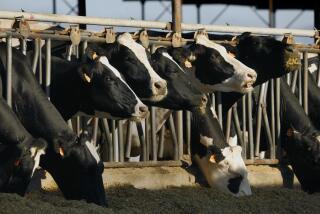Rustling Up a Pair of Lost Cows
My son, the teacher of reading, has always been exactly like his father when anything mechanical or agricultural is concerned. When Tim was a small boy and Doug successfully replaced an ice tray in the refrigerator, Tim and I would applaud and say, “Oh, look what Daddy did.”
Now Tim has changed from an urbane young man just out of college with an apartment on Telegraph Hill in San Francisco to a hewer of wood and a drawer of water in the desert town of La Quinta.
Last year, he and his friend, Brad Bertling, the flying instructor down the road, went into the cattle business. Oh, nothing that would ever concern the King Ranch in Texas. They bought six head.
The first wonderment came when Tim went out one morning to toss the cows some hay and there was a brand new calf. A few days later, there was another one. Tim and Brad had been assured that none in the herd was about to do any such thing.
A few months ago, Brad and Tim, the cattle kings of North Shore near the Salton Sea, decided to take three of the cows over to Dos Palmas Ranch, 1,600 acres of lush green grass, anchored by ponds of cool water. The move would eliminate the need for taking hay to half their adult cows every day.
On the day of the great cattle drive, Tim drove the pickup, Geri, his wife, drove her car. I believe Rod Chamberlain brought up the rear in his truck. There was some talk of Brad herding the threesome from the air in an airplane but steadier heads, heaven knows whose, prevailed.
They finally got the chosen three cows the three miles or so to Dos Palmas (an old stage stop, surrounded by a date palm grove), and the cows were so glad to be out of that triangle of noisy vehicles, they took off for the high country. They had several delightful months, dining on lush green grass and drinking nice cool water.
Then the blow fell. The Nature Conservancy bought the ranch from the owner, Jack Prince, a car dealer in Inglewood.
The conservancy wanted the cattle off the property. Inasmuch as no one had even seen the threesome for some weeks, it was daunting to think of finding them on 1,600 acres.
But the reading teacher and the flying teacher set out for the most significant cattle drive since the ones from El Paso to Abilene.
They could not find the cows. They looked every day for days, creeping around in the grass, carrying ropes because they thought they should.
One day Rod, a marine biologist from UC Santa Barbara, was riding in the dune buggy with Tim driving when they spotted a cow. Rod threw a lasso around her startled neck. Rod was raised in Eureka, and used to ride in the wild horse event at rodeos.
Geri says she is sure the cows were laughing themselves into fits of collapse while all four of them ran around with loops of rope in their hands.
The new property owners were becoming testy, although the bovine twosome still there seemed a nice pastoral touch to me. But the Nature Conservancy wanted its property cow-free.
After Rod’s triumph, the cowboys set out several days later to try again--in pickup trucks, dune buggies and civilian cars. Louis L’Amour would have wept.
When they reached Dos Palmas, the two missing cows were standing in the 100-square-foot corral, gentle-eyed, with “Who, us?” looks on their faces.
It was Alejandro who accomplished the roundup. He works at Dos Palmas and knew of the great cattle drive. He often helps Tim. Alex, as he is known, had started at the far edge of the 1,600 acres, and scattered lovely, blue-green alfalfa clear across the acreage and into the corral. His mother must have read him “Hansel and Gretel.”
One of the cows started down the alfalfa trail and the other followed.
Now they have been sold, and the problem is solved. Actually, I think everyone is a little sad. For a few days there, the boys could play John Wayne while the cows played “Don’t Fence Me In.”
More to Read
Sign up for Essential California
The most important California stories and recommendations in your inbox every morning.
You may occasionally receive promotional content from the Los Angeles Times.










